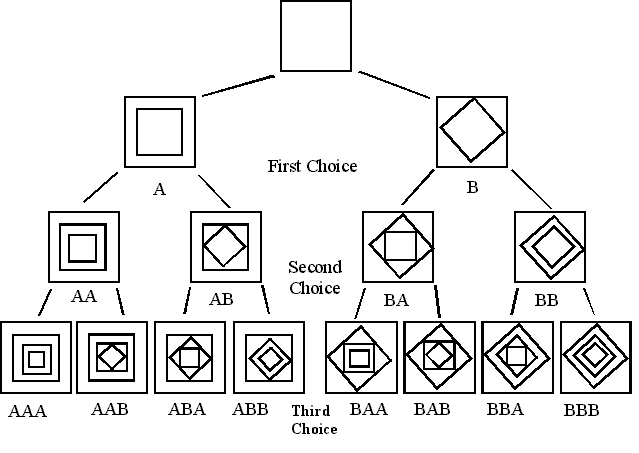
The
Eight Design Arrangements
&
Their I Ching Correspondences
|
The principle of synchronicity upon which Jung found the I Ching to be based is a choice-making process. So is the Infinite Possibilities Mandala Maker. It is therefore not surprising that this particular method of making mandalas comes also bearing inner wisdom from which it is possible to discern guidance and counsel. And one of its messages is that our choices are greater than we might have believed, and also far less to be feared than we may have imagined. Life's crisis are often intersections where there seem to be no or limited choices, or sometimes situations in which we fear making wrong choices. Then, or in preparation for such times, making mandalas is an exercise in daring to choose, and then choose again and again. For each mandala made according to the IPMM method ten choices are required--seven involving color and three concerning arrangement. Traditionally mandalas have been created for "focusing" and "centering" in meditation. When used in conjunction with a Mandala Journal this method facilitates a flow between the symbolic or visual and the logical or verbal levels of consciousness. Just how one taps into wellsprings of creativity is suggested in "There is No Sound in an Empty Room," (Joan Richardson, Co-Evolution Quarterly #55) wherein the author notes the old Chinese belief that the ideal number of poems in an anthology to be around 300. It was thought that by thoroughly coming to know that number of poems persons would themselves know how to compose a poem. Similar rewards are to be gained from diligently spending time in creating mandalas, and over a sufficiently long period of time. If this method is undertaken as a daily discipline or approach to inner work, and if as part of this the mandalas and the process of making them are interacted with through journaling, you will experientially come to know more about color, more about symbol, and about balance and choice-making than ever you could have imagined. If you are familiar with the I Ching, the ancient Chinese "Book of Changes," or for that matter computer mathematics, you already know that with two "this or that" choices and three variables involving the two choices, the arrangement possibilities number eight. In the I Ching the two choices are for "Yin" ( _ _ ), the earth principal, and for "Yang" ( ___ ), the heaven principle. These two, when formed into three-line trigrams, yield the eight possible arrangements as show in the illustration at the top of this page. In creating a mandala according to this method, the dynamics are determined when each of the three inner squares are placed either squarely or diagonally. It is important that this be done with as much spontaneity as possible. In this way the total impact of a design becomes either more or less passive or active. As for the fourth or largest square, it serves as the unmovable foundation upon which the mandala is built, while the three circles always remain in their same relationship to the squares and to each other. When this symbolism of levels and colors is related to the levels or dimensions of consciousness the implication is of an interfacing or interpenetration of the influences of spirit (heaven) and matter (earth). In any truly creative endeavor in which we are open to the influences of "heaven" we feel inspired--in-spirited and energized. |
||
T |
||
|
How
the
Three "A" or "B" Choices Lead to |

|
Above the three choices between "A" (Yin--passive) or "B" (Yang--active) are diagrammed to show how progressively they lead to the eight possible arrangements. In this way, the three innermost squares yield the eight design possibilities in arrangements that range from the most static (AAA), and therefore most restful design, to the most dynamic (BBB), or most energized arrangement: From this and the advancing or receding characteristics of the seven colors incorporated into a mandala it is possible to discern a great deal about the process of change and movement in our own lives or in the lives of those with whom we may be engaged in counseling or art therapy. Sometimes persons who appear to be extroverts will say they think of themselves as introverts. To go beyond labels, a mandala made today will be a reliable reflection of the direction one's energy is wanting or needing to go for the sake of the overall balance of the psyche. But over a period of time there may also be a consistency to a person's tendency or preference for one end or other of the spectrum and for arrangements that are tend to be balanced (ABA and BAB) or fall at one extreme or the other (AAA or BBB) or somewhere in between (AAB / ABB or BAA / BBA). To the
degree that a mandala is constructed by relying on intuition and feeling in
making the and arrangement choices, the symbolism will be reflected in that of
the eight I Ching trigrams. After identifying the number of an
arrangement, consult the correspondence chart below. |
||||||||||||||||||||||||||||||||||||||||||||||||||||||||
Chart of Symbolic
Correspondences |
||||||||||||||||||||||||||||||||||||||||||||||||||||||||
|